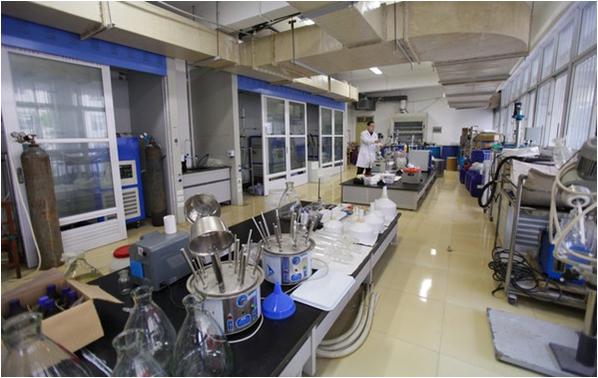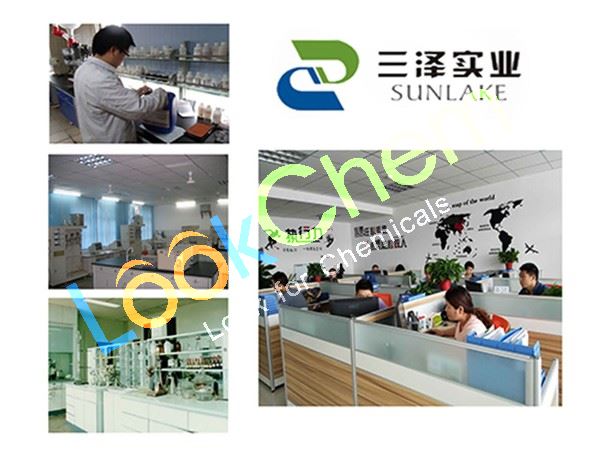Product Certification&
Enterprise Certification
Country: ![]() China (Mainland)
China (Mainland)
Business Type:Trading Company
Mobile:
Tel:
Fax: +86-371- 86259723
Province/state: HENAN
City: ZHENGZHOU
Street: Mingmen International Center, NO.222 Dongming Road,Zhengzhou,Henan,China
MaxCard:
 Contact Suppliers
Contact Suppliers
CAS NO.133-32-4
HENAN SUNLAKE ENTERPRISE CORPORATION
Our company advantages:
1、The highest quality with the competitive price.
2、Professional human services.
3、The fastest and safest delivery service.
4、The faster and safest delivery service.
5、The high purity products.
6、We have a sufficient supply of stock.
7、A variety of payments, such as L/C, TT, , MoneyGram or other payments.
Henan Sunlake Enterprise Corporation is located in Henan Province , The central plain of China , Which enjoys favorable geogeaphical position and convenient transportion. The com[any was established in june. 1998, until now having more than 18 years experience in manufacturing & exporting chemical raw material .
Sunlake is a professional manufacturer engaged in producing and selling chemicals,including Organic & inorganic chemicals , pigments & Dyestuffs , Water treatment chemicals , Food & FEED additives and others. These products have been being well exported to europe, southeast Asia, the Middle East ,Africa, South America and some other countries and areas.
We sincerely welcome foreign friends to visit our plant for cooperation. With the idea of "quality first,credit priority, Excellent service", We are highly acknowledged by customers for good quality and competitive price. More importantly , the company has a strong R & D team, who are professional engineers and scholars with Ph. D. .So we are confident to serve you better with our high - quality products and professional team. We are taking great efforts to provide our customers with demanded goods and professional services, and continuously improve our core ability of competition and get the momentum for sustainable development, and finally make us being a reliable and professional supplier in international market.
We welcome any serious inquiries from all customers of the world, and sincerely hope to cooperate with you for a brilliant future!


3-Indolebutyric acid Basic information
| Plant Growth Regulator Physical and Chemical Properties Preparation Analytical method Toxicity Chemical Properties Application |
| Product Name: | 3-Indolebutyric acid |
| Synonyms: | Seradix;1h-indole-3-butanoicacid;3-indolyl-gamma-butyricacid;4-(indol-3-yl)butyricacid;4-(indolyl)-butyricaci;beta-indolebutyricacid;gamma-(3-indolyl)butyricacid;gamma-(indol-3-yl)butyricacid |
| CAS: | 133-32-4 |
| MF: | C12H13NO2 |
| MW: | 203.24 |
| EINECS: | 205-101-5 |
| Product Categories: | indole derivative;Fatty & Aliphatic Acids, Esters, Alcohols & Derivatives;Carboxylic Acids;Pyrroles & Indoles;Indole;Organic acids;PLANT GROWTH REGULATOR;Auxins;Biochemistry;Indoles;Plant Growth Regulators;Simple Indoles;Plant Hormones;Carboxylic Acids;Pyrroles & Indoles;Heterocycles;Indole Derivatives;plantgrowth;fertilizer;Inhibitors;Agricultural Usage |
| Mol File: | 133-32-4.mol |
|
|
|
| 3-Indolebutyric acid Chemical Properties |
| mp | 124-125.5 °C(lit.) |
| storage temp. | 2-8°C |
| Sensitive | Air Sensitive |
| Merck | 14,4965 |
| BRN | 171120 |
| Stability: | Stable. Incompatible with strong oxidizing agents. Light sensitive. |
| CAS DataBase Reference | 133-32-4(CAS DataBase Reference) |
| EPA Substance Registry System | 1H-Indole-3-butanoic acid(133-32-4) |
| Safety Information |
| Hazard Codes | T,Xi |
| Risk Statements | 25-36/37/38 |
| Safety Statements | 26-36-45-38-36/37/39-28A |
| RIDADR | UN 2811 6.1/PG 3 |
| WGK Germany | 3 |
| RTECS | NL5250000 |
| F | 8-10-23 |
| Hazard Note | Irritant |
| TSCA | T |
| HazardClass | 6.1 |
| PackingGroup | III |
| HS Code | 29339990 |
| Hazardous Substances Data | 133-32-4(Hazardous Substances Data) |
| 3-Indolebutyric acid Usage And Synthesis |
| Plant Growth Regulator |
Plant growth regulators are artificially synthetic, physiologically active organic compound that is similar as plant hormones in regulating physiological processes of plants, controlling of plant growth and reproduction of organic compounds. Indole butyric acid (IBA) and naphthalene acetic acid (NAA) are two commonly used plant growth regulator in rooting cuttings with indole butyric acid working best because it has less operation in plants and is easy to be maintained in the vicinity of the site. Furthermore, using root pro-growth regulators in combination with other beneficial growth regulators can play an efficacy-enhancing role or synergistic role which enable a more satisfactory results for plants which are difficult get rooting. Indole butyric acid has a strong rooting-promotion effect but has the adventitious roots be thin and long while the rooting-promotion effect of naphthalene acetic acid (NAA) is less but coarse root. Therefore, we can usually get better results through the mixture of the two. In 1928, Went (F. W. Went) had first successfully isolated this chemical messenger which causes the bending of the coleoptiles, named auxin. In 1934, Kogl (F.Kogl), etc has identified it as indole acetic acid. Accordingly, the indole acetic acid is often used as a synonym for auxin in custom. Shortly after recognizing the role of indole acetic acid on regulating the growth effect, scientists further found that indole propionic acid (IPA) and indole butyric acid (IBA) also has physiological effects similar to auxin. Later it was also found that naphthalene acetic acid (NAA), 2,4- dichlorophenoxyacetic acid (2,4-D), 2,4,6- trichloro-benzoic acid and 4-amino-3,5,6-trichloro-pyridine carboxylic acids and their derivatives (including salts, esters, amides, such as sodium naphthalene acetic acid, 2,4-D butyl ester, naphthyl ethyl amide) all have the activity of auxin. 3-Indolebutyric acid is not easy to be oxidized in plants and has a poor conductivity. It has similar physiological effect as indole acetic acid. It can take effect in cell division and cell growth of plants but with a less significant effect compared with indole acetic acid is mainly used to promote rooting cuttings and effectively promote cell division cambium. It has a relative long maintaining time for its efficacy and can promote more but slender adventitious roots with better efficacy when being administered together with naphthalene acetic acid. Indole-3-butyric acid can be applied to the cuttings and root cutting of chrysanthemum and other ornamental plants for facilitating the rooting at a concentration of 0.5 ~ 1.0mg / L. However, we should not be applied to the foliage of the plants. Degradation and Metabolism: it can subject to rapid degradation in the soil. The above information is edited by the Chemicalbook of Dai Xiongfeng. |
| Physical and Chemical Properties | 3-Indolebutyric acid: (molecule formula: C11H12O2N) has a molecular weight of 190.22. The pure product is white crystalline solid with the melting point being 124 ~ 125 ℃. Its industrial product is white to pale yellow crystals with a melting point being 121 ~ 124 ℃. It has special smell and is toxic! It is irritant with a vapor pressure being <10μPa at 60 ℃. It is difficult to be dissolved in water with the solubility in water at 20 ℃ being 0.25g / L. It is easily soluble in benzene and soluble in other organic solvents. Its solubility (g / 100ml) is: benzene> 100; acetone, ethanol, ethyl ether: 3 to 10; chloroform: 1 to 10. 3-indolebutyric acid has a low toxicity to humans and animals and is stable to the acid while forming salt in the solution of the hydroxide and carbonate compounds of the alkali metal. It can be produced from indole via Grignard reaction or by adding nitrile for hydrolysis. In Agriculture, 3-indolebutyric acid can be used as plant growth-promoting agent that can promote root growth and fruit ripening with an efficacy being stronger than indole acetic acid. Indole butyric acid is an excellent growth regulator for promoting the cutting and rooting of the cherry rootstock. You can apply rapid high-concentration dip method or soaking for treatment of cutting slips. Rapid high-concentrations dip method is through dipping the base of the cutting slips in IBA solution of a concentration of 5 × 10-4 ~ 1 × 10-2 for 5 seconds and immediately inserting the cutting slip in the bed. This method has the advantage of short processing time, even medication and excellent efficacy. After the treatment, adding simazine to the insertion beds (20.375 grams per meter) can lead to a higher rate of rooting. |
| Preparation |
Laboratory put the mixture of indole, potassium hydroxide, and poly oxalic acid, dried tetrahydronaphthalene and γ-butyrolactone for heating under reflux to obtain the indole butyric acid. The reaction equation is as follows: Indole, potassium hydroxide, poly oxalic acid and dried tetrahydronaphthalene were added to the reaction vessel. The mixture was stirred for half an hour at room temperature; add γ- butyrolactone for heating reflux for 4 hours. The water remaining in the reaction system is removed by the water segregator. After cooling, the solid was totally dissolved by water with the separated organic layer being acidified with hydrochloric acid for precipitating a large number of off-white solid. Use suction filtration, wash with water, and dry to give the crude indole butyric acid with the yield of the crude product being 92.6%. After recrystallisation but aqueous ethanol, you can obtain white flaky crystals that is indole-3-butyric acid with the mp being 121.5 ~ 123 ℃. Reference: Daquan Wang (editor), “fine chemical production route” 2nd version, Beijing: Chemical Industry Press .1999 p. 260-261. |
| Analytical method |
1. Product analysis: in the absolute ethanol, measure it at wavelength of 281nm through UV spectrophotometry (ACF Chemiefarma method). 2. Residue Analysis: use chloroform for extraction from the acid medium, and put its methanol solution together with petroleum ether (40 ~ 60 ℃) for shaking absorption, and further use high performance liquid chromatography for applying ultraviolet detection (ACF Chemiefarma France). Alternatively, you can also refer to the indole acetic acid residue analysis. First derive methyl or the trimethyl ester of silane, and then use gas chromatography for analysis. |
| Toxicity | It has low toxicity to humans and animals. Acute-oral rat: LD50: 5000mg / kg, mice 1760mg / kg. Carp LC50: 180mg / L (48h). It has low toxicity to bees. |
| Chemical Properties | The pure product is white crystals. m.p.124 ~ 125 ℃, vapor pressure <10 × 10-6Pa) (60 ℃). It is easily soluble in organic solvents but insoluble in water. It is stable to acid. The industrial product is white to pale yellow crystals with a melting point of 121 ~ 124 ℃. |
| Application | Indole butyric acid (IBA) is a broad spectrum indole-class plant growth regulators and is a good rooting agent. It can promote the cuttings and rooting of herbaceous and woody ornamental plant. It can also be applied to the fruit setting of fruit as well as improving the fruit setting rate. |
| Chemical Properties | white to light yellow crystalline powder |
| Usage | Used to stimulate root formation of plant clippings. Suitable for plant cell culture tested. |
| 3-Indolebutyric acid Preparation Products And Raw materials |
| Raw materials | Potassium hydroxide -->Indole-->gamma-Butyrolactone-->Poly(ethylene glycol)-->1,2,3,4-Tetrahydronaphthalene-->BUTYRONITRILE |